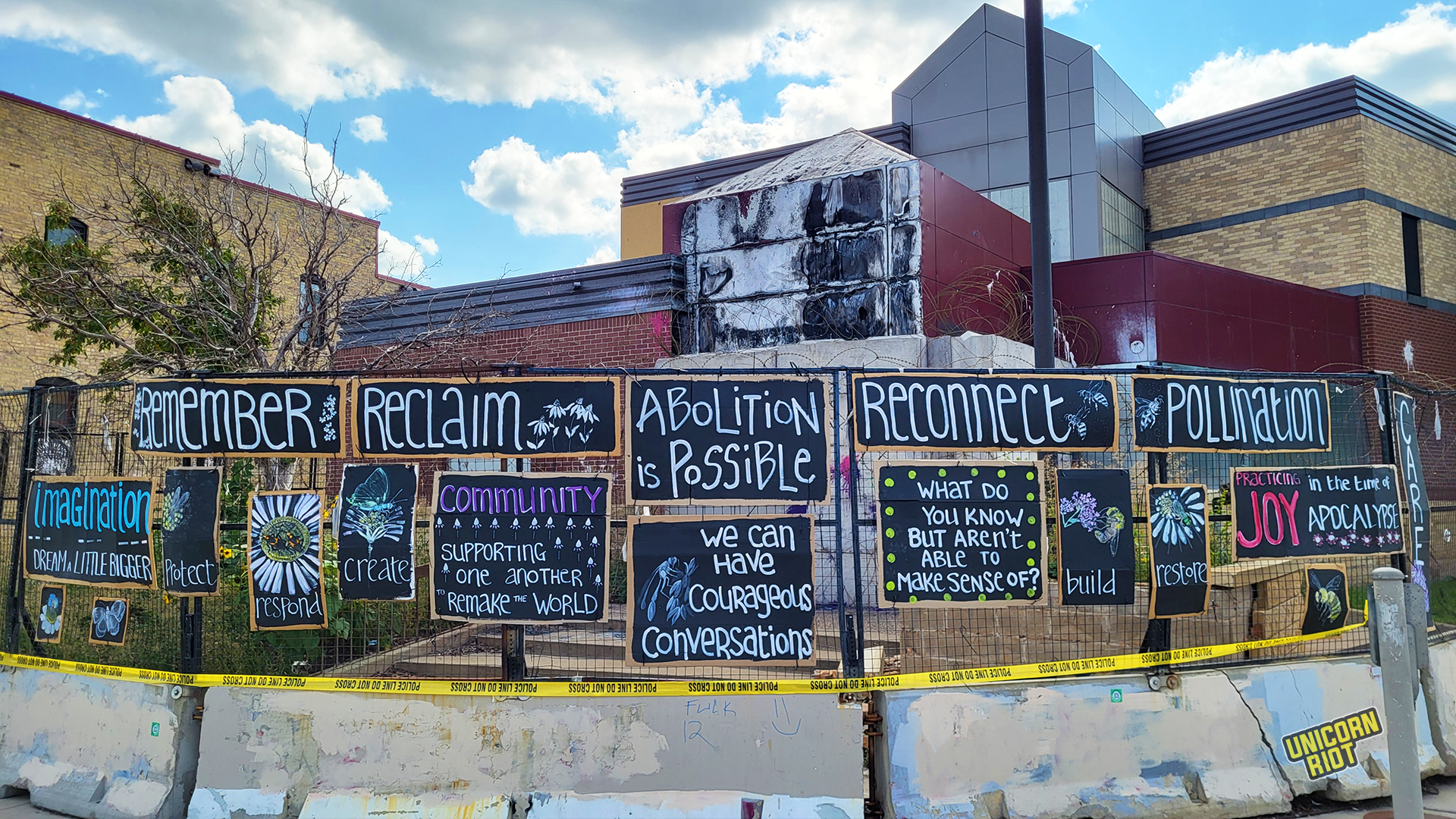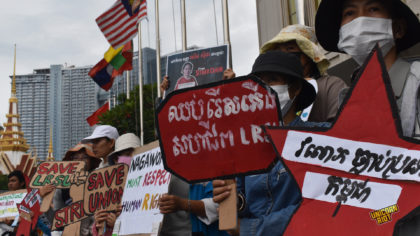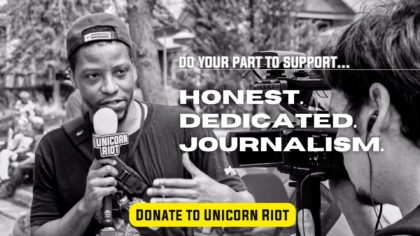Film: An Infamous Precinct in Ruins and a Community Organizing Itself
After Three Plus Years, A Contentious Decision for MPD’s 3rd Precinct Passes
Minneapolis, MN — Minneapolis has decided on a new site for housing its police department’s 3rd Precinct. Three and a half years after thousands of community members ransacked and torched the precinct at 3000 Minnehaha Avenue during the George Floyd Uprising, Minneapolis Mayor Jacob Frey received approval for a new precinct at 2633 Minnehaha Avenue on November 2, 2023, which the city is calling a “Community Safety Center.”
Throughout the years, the city government worked to find a new precinct location — this year they sought insight from its constituents and conducted a public survey and held community engagement sessions. But with the years-long oppositional movement that had formed to counter the project, the process became contentious.
In response to the city’s moves, activists held block parties, protests calling for “no new precinct” and organized their own public assemblies on community safety while unknown parties vandalized the new building, multiple times.
Seeking to bring light and give space to some of the many Minneapolis residents against a new 3rd Precinct location, Unicorn Riot heard from community organizers, a Minneapolis City Council member and a former Minneapolis police officer. They spoke about the community not wanting the precinct rebuilt and about the ongoing neighborhood assemblies. With the new headquarters for the 3rd Precinct officers in mind, Unicorn Riot looks back at the tumultuous events leading up to this point. See our 19-minute film below.
City Fails at ‘Manufacturing Consent’ With Public Survey and Community Engagement Sessions
[Spring/Summer 2023]
For years, city councilors and residents have continuously grappled with the mayor, whose power was recently expanded, in a convoluted battle over the future of the 3rd Precinct. This year, the mayor has been called out by a city councilor for “manufacturing consent” and for blatantly disregarding his residents to appease his “pro-police” and “corporate base” during this drawn-out process.
Several locations were proposed over the years, with two locations on the same block at 2600 Minnehaha and 2633 Minnehaha. In the Spring of 2023, the city launched a public survey asking residents where they want to rebuild the 3rd Precinct. However, the survey listed only two options: the burnt-up location or a new one a few blocks down at 2600 Minnehaha Avenue — across the street from the newly approved precinct location.
Minneapolis City Council Member Robin Wonsley, whose Ward 2 district includes parts of the 3rd Precinct, told Unicorn Riot that her constituents said they felt they were being presented with the illusion of choice: “[The city’s] asking us if we want to be punched in the face or punched in the stomach, and we don’t want either.”
Wonsley said trust in the city and the police has been eroded over the years. She summed up the sentiments she and her staff heard from constituents: “‘Do your damn job and deliver on a comprehensive model of public safety. Don’t even talk to us about police precincts.’”
After the public survey, city staff held a series of public community engagement sessions. Heather Johnston, the outgoing Minneapolis City Coordinator who has been embroiled in scandals since she was appointed by Mayor Frey, co-facilitated the sessions with Karen DeYoung from DeYoung Consulting, a Black-owned firm contracted by the city. (Johnston was accused of racism and retaliation by her own staff.)
The engagement sessions attracted over a thousand people, and while supporters of rebuilding or replacing the precinct were present, the majority expressed opposition — as shown in the report that was later released.
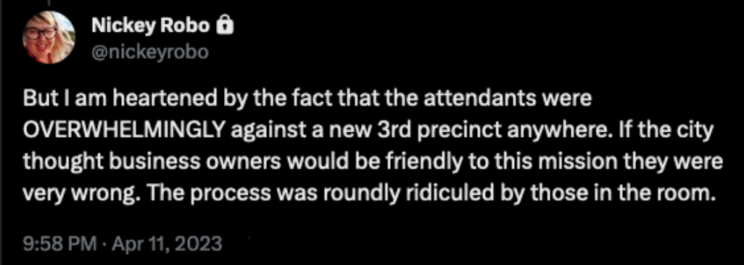
Former MPD officer-turned-activist, Sarah Saarela, attended the community listening session held at Roosevelt High School. She knew going into the meeting that community members were outspoken against the city’s plans, but she said she wasn’t expecting to hear what she heard.
“It was very evident that there’s still a lot of trauma within the community. Not just since the murder of George Floyd, but decades before that. They told stories,” she said.
“I knew it was the truth because I recognized it. And their anger is still so fresh. Their trauma is still ongoing. And by far the majority of people that spoke do not want another 3rd Precinct built, anywhere,” she added. “They made that very, very clear.”
The city hosted its final session at Sabathani Community Center, an historic African-American institution just a couple blocks from George Floyd Square. The Sabathani audience was a fairly diverse group, yet were overwhelmingly against rebuilding a new police station, according to attendees.
One attendee, during the session’s breakout groups, compared the city’s actions of rebuilding the police station to domestic violence. “This is like requiring a person to go back and buy their abuser a new house. Like how are you going to justify that?”
After documenting the public feedback from the surveys and from the engagement sessions, DeYoung Consulting released its report on July 17, and gave a presentation to the City Council the next day.
Watch the presentation of the report to the council below.
The next week, the Minneapolis City Council made a “commitment not to house any police facility or functions” at the old, scorched precinct. This was approved by Mayor Frey on July 25.
“The city had a whole series of listening sessions and surveys and all this other stuff. And what came out of it is that thousands and thousands and thousands of people said, ‘We don’t want the 3rd Precinct back.’”
Michelle Gross, President of Communities United Against Police Brutality
On December 5, city staff presented various recommendations to the City Council to figure out what to do with the former 3rd Precinct. These included a Public Works Traffic Facility, a Farmers Market Site, Animal Care and Control Facility, Hiawatha Training Facility, a Water East Yard, and an Election and Voter Services site as “potential city site uses.”
A 3rd Precinct Rebrand Amid Back-and-Forth Location Proposals
[Summer/Fall 2023]
After the report was released, Mayor Frey’s office made an announcement saying the city was looking to relocate all of the 3rd Precinct officers, a total of 99, to a downtown location along with the 1st Precinct, potentially in the Century Plaza building.
Former officer Saarela was quoted in DeYoung’s report calling for the city to do just that — combine precincts as a better “use of the city’s financial resources.”
“With the Minneapolis Police Department down 300 officers, there’s been no evidence showing Minneapolis is any less safe. If every precinct is down 60%, put them together.”
Sarah Saarela, DeYoung Report
Council Member Wonsley said she was in support of the plan to combine precincts. She said she’s been leading committees on what “it look[s] like with our police force in decrease,” and that many of her constituents in Ward 2 didn’t want the officers housed in any location in their ward.
The co-location plan was scrapped after the details emerged. “Staff came back and basically said that this is going to cost tens of millions of dollars and it’s only a temporary solution,” said Wonsley.
This was another “switcheroo” from the Frey administration, Wonsley said. They pushed for a rushed decision by “once again, manufacturing urgency” and saying publicly during the press conference, “we need to make a decision.”
“Honestly, we had been doing our due diligence from the start and in response to a botched process that [Mayor Frey] led,” said Wonsely. Frey “manufactured all of this – created a crisis that was not necessary.”
Heading into the Fall, council members Wonsley and Jason Chavez, whose wards are served by 3rd Precinct officers, continued to speak to their constituents about what the community was hoping for in terms of a new precinct and for community safety.
On October 4, Mayor Frey sent a letter to the City Council urging them to act quickly on his unilaterally chosen site of 2600 Minnehaha and calling it Minneapolis’ first “comprehensive safety center.” Frey’s wishes were published in the Star Tribune and he gave the Council three reasons to vote – two of which scolded the Council: “First, it’s located within the Third Precinct … Second, the Council has removed the other two options provided by staff from consideration — both of which I would also support. Third, any potential site brought to the table now would cost significantly more money and time, neither of which we have.”
Council Member LaTrisha Vetaw, who serves Ward 4, the city’s most northern parts and is one of Frey’s main allies on the council, published an opinion in the Star Tribune the next week titled, “Rebuild Third Precinct at its old home.” Vetaw said the city was “wasting time and money due to a small, vocal group of activists.”
In maybe the final turn of events in mid-October, city staff were alerted by the owners of 2633 Minnehaha that they were, once again, willing to sell their building and property. This property was previously proposed in 2020, but the owners withdrew their deal after they received threats and the building was vandalized.
By early November 2023, Mayor Frey received approval for $10 million to purchase the building and property at 2633 Minnehaha Avenue, plus an additional $4 million to renovate it.
The plan was approved by the City Council on Nov. 2 in an 8-5 vote, with council members Vetaw, Emily Koski, Linea Palmisano, Andrea Jenkins, Andrew Johnson, Lisa Goodman, Jamal Osman and Michael Rainville voting for the proposal. Council Members Wonsley, Chavez, Elliott Payne, Aisha Chughtai and Jeremiah Ellison voted against the purchase of the building.
“What we’re seeing right now is Mayor Frey, in a desperate attempt to prove to his supporters, and his corporate base and the pro-police faction that they’re still in control and that the status quo will prevail.”
Robin Wonsley, Minneapolis City Council Member
Read the city’s legislative directive on what they’re calling a “community safety center” below:
The 2633 location was again vandalized shortly after the approval. Anti-police and pro-Palestinian sentiments were spray-painted on the building. The police have since stationed a large mobile surveillance camera on the property.
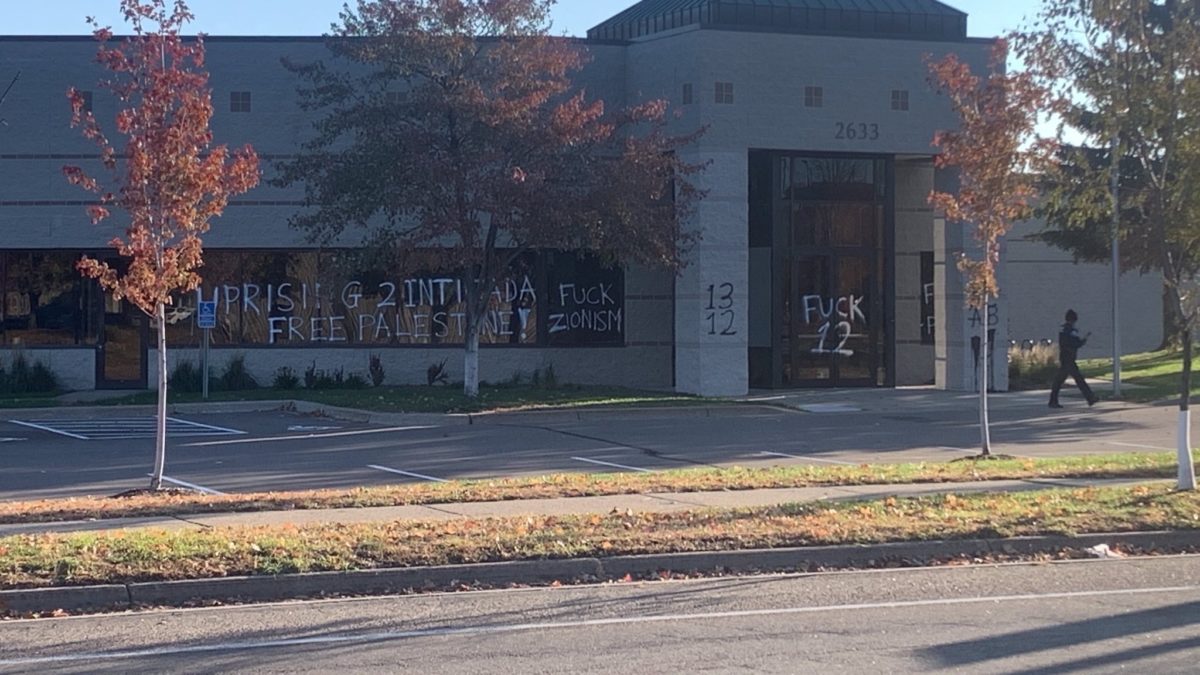
3rd Precinct: A House For Criminal, Predatory Officers
Protesting the 3rd Precinct isn’t new in Minneapolis, where for generations, it’s been infamous for its violence and corruption.
Council Member Wonsley referenced the 3rd Precinct police station’s dark history going back decades, comparing it to the Chicago Police Department’s notorious “black sites.”
“That has been a site of torture for decades,” she told Unicorn Riot. “Some of the worst crop of MPD officers were stationed there.”
“They should have been classified as a threat to humanity from the United Nations like they did with the Chicago Police Department, where they say, like ‘You have engaged in torture tactics.’ That’s exactly what the 3rd Precinct history embodies for the City of Minneapolis.”
Robin Wonsley, Minneapolis City Council Member
Saarela, who did her officer field training at the 3rd Precinct three decades ago, said it was the most unaccounted for of all the precincts.
“When the department knows that a cop has committed heinous brutality, even murder,” she said, “they know those supervisors won’t hold their cops accountable. So a lot of them were placed in the 3rd Precinct.”
Past investigations into MPD by Unicorn Riot discovered a program from 1976 created by the 3rd Precinct to address community concerns of racism and police brutality. According to a report released in 1983 by the U.S. Justice Department about the program:
“A major complaint from residents, especially blacks and Native Americans, was about the police department. Residents did not trust the police and felt that they were treated unfairly by them. There was also resistance from the police department to dealing with neighborhood groups, because it was felt that organized residents would create demands on the police that they could not meet.”
Their goal with the program was to outsource the job: to enlist neighbors in policing each other. However, well before the uprising of 2020 and the torching of the 3rd Precinct, it was clear that the site remained notorious for its corruption and violence against the community.
The Spring 2023 report by DeYoung Consulting noted, “Many participants feel that the community is safer without the police. Some believe that the police do not really solve crimes while some believe that the community has been safe without them.”
Saarela agrees. She knows from experience and remembers how violence was celebrated by cops at the 3rd Precinct.
“Because of their violence, because of their racist brutality, a lot of the times those officers were very well respected,” she told Unicorn Riot. “They took pride in the fact that they were violent. I was more afraid of them than any community member that I had ever met.”
That violence reverberates through the community. Small business owners in Minneapolis, who are routinely extorted by the police in a protection racket, are quoted in the DeYoung report saying how “MPD officers are bad neighbors who have little regard for human life.”
Several local shop owners said they’ve been getting a shakedown by MPD with pressure to hire off-duty cops for security or face being “blacklisted.”
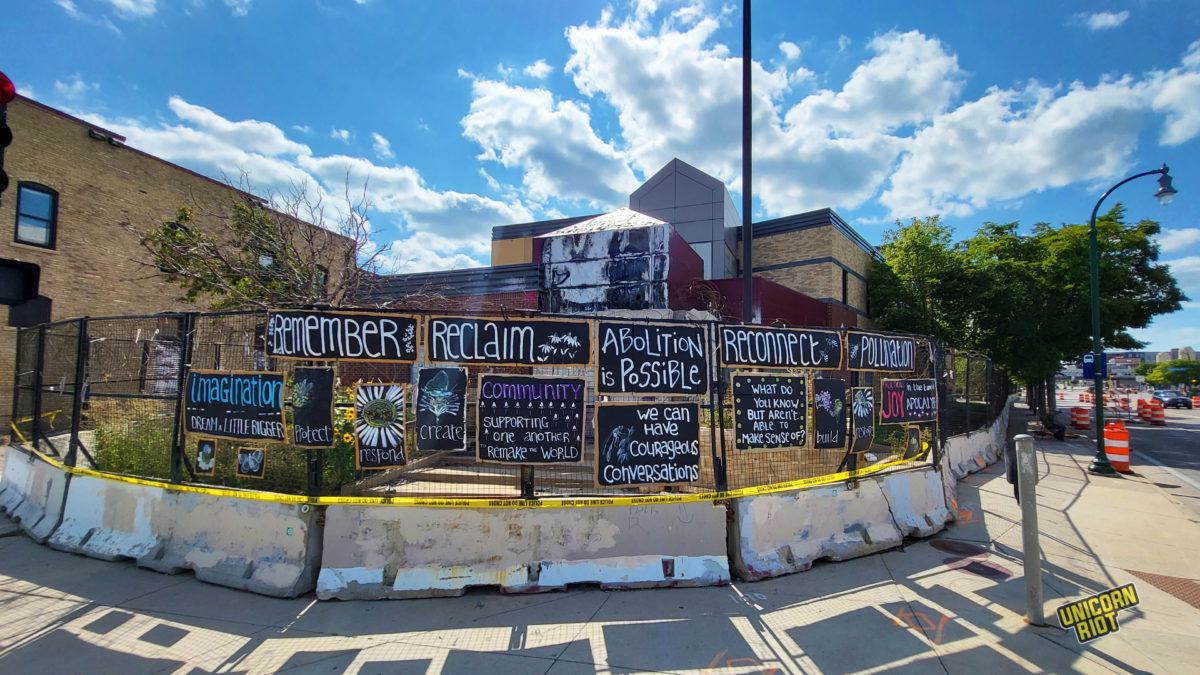
Communities Organizing Themselves
Residents have rallied numerous times over the past three years to oppose any plans to rebuild or relocate the police station, including on October 22 for the 28th annual National Day of Protest Against Police Brutality, when activists and impacted families gathered outside the precinct ruins under the main theme of “no new precinct.”
“This precinct has been a scourge on this community and this town for decades. So we’re here to say that we do not want a 3rd Precinct back in the neighborhood. They have not earned their way back into the community. They have not done anything to correct their conduct. People are still filing complaints about officers that are part of the 3rd Precinct. This must end!”
Michelle Gross, President of Communities United Against Police Brutality
Protests are just one of several ways community members have been organizing. While some organizers pushed for residents to attend the city’s engagement sessions, others created their own sessions.
Community organizers Duaba Unenra and Sam Gould held a separate series of engagement sessions they termed assemblies that are guided around public safety and what that looks like for different community members and neighbors, specifically in the 9th Ward.
The duo are co-founders of Confluence Studio, whose Autonomous Mobile Media Unit, a radical print shop and social platform, was recently featured by Unicorn Riot. The Studio began holding assemblies this past spring on the second Saturday of every month at 3 p.m. in South Minneapolis.
The pair said that their work is rooted in creating a future with no precincts.
“We form different working groups to investigate different issues around security in our neighborhood,” Unenra said, regarding neighbors who are preparing to sustain themselves without police. “People [are] taking the authority to run their neighborhoods in their own hands.”
“We can reclaim our own sense of identity,” he added. “We’re the government of the city.”
Gould said that their goal with the monthly assemblies is to create a space to build community, report on what they have heard from their neighbors, and focus on “growing that public.”
“It’s about creating affinity groups from neighborhood to neighborhood, from city to city, from state to state, where similar tools can be used, but the culture and relationships on the ground get to play out in what they know,” he said. “So hopefully the more this gets done … the less we have to have conversations about crisis and the more we can have conversations about creation and creativity.”
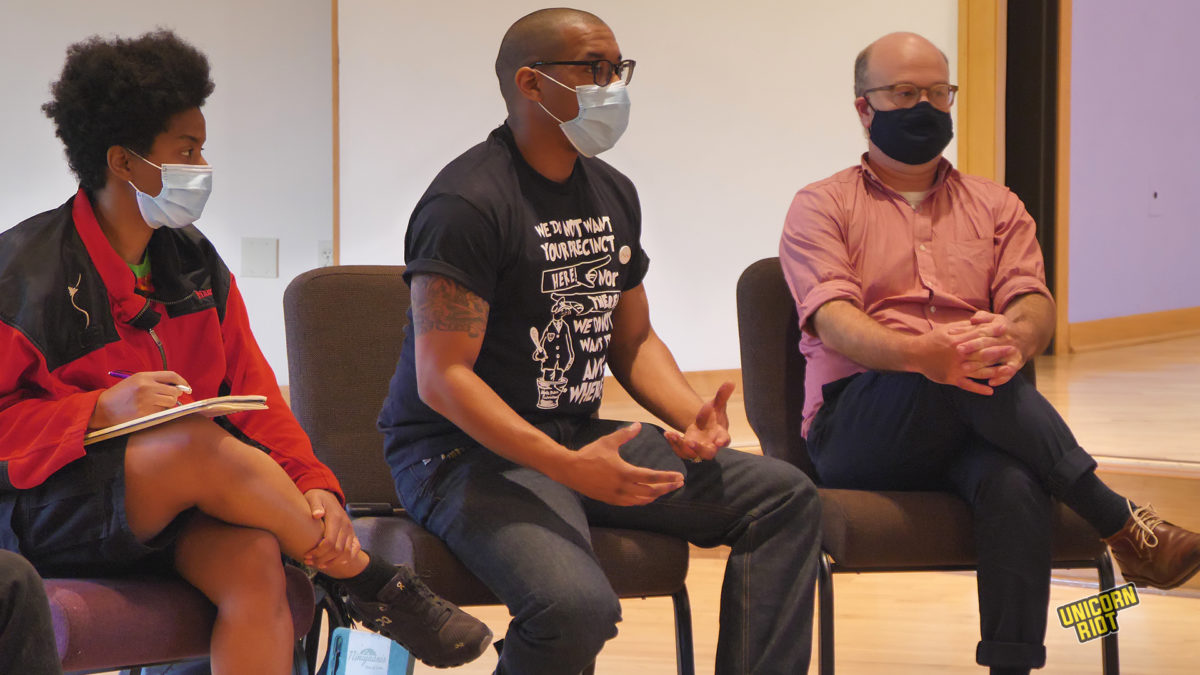
In conjunction with the assemblies, Unenra and Gould are also seeking the international public’s ideas and submissions for ‘The Future in Ruins: Overwriting the Third Precinct’ — an autonomous request for proposals to “reimagine the Third Precinct complex from the ground up.” They’ve recently extended their deadline for submissions. For more information about the RFP or assemblies, visit their website and follow their Instagram.
The old 3rd Precinct building is slated for a Spring 2024 “cleanup,” according to the city. Cleanup of the site will, they say, “secure the building,” “improve appearance of the site,” and allow them “to remove barriers” that have surrounded the precinct since May 26, 2020.
The city, meanwhile, is estimating that building out their new “Community Safety Center” will take 9 months from the time they gain control over the site from the sale.
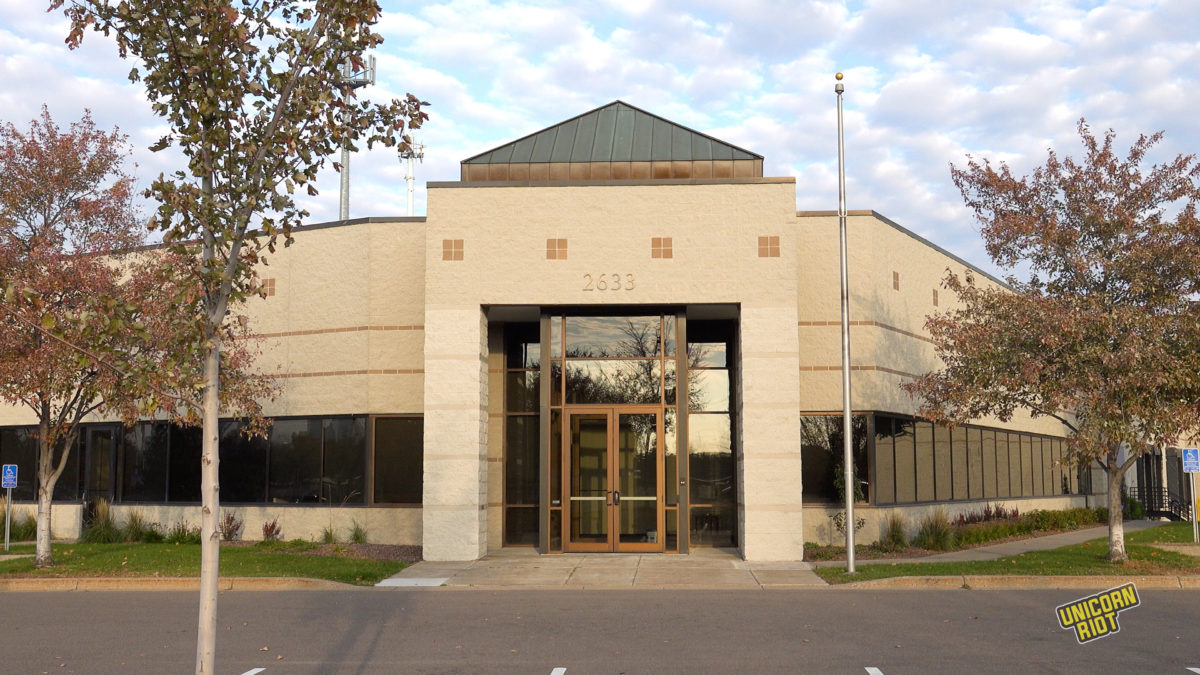
Related:
Minneapolis Official Speaks Out About ‘Corruption’ Lack of Gov’t Oversight and ‘Useless’ City Council [Aug. 2023]
Unicorn Riot’s Reporter Reflection series spotlights footage from the frontlines of the George Floyd Uprising. Episode 3 Part 1 features the jarring moments that led up to the besiegement of the 3rd Precinct in Minneapolis, where Derek Chauvin was previously employed. May 28, the third day of the uprising, was the most significant as the community continued directing its outrage at the 3rd precinct leading to it being ransacked and set on fire, something that has historically never been done in response to racial injustice. The next day, Derek Chauvin was charged with third-degree murder and second-degree manslaughter charges.
Episode 3 Part 2 features interviews with three of George Floyd’s friends and brings perspectives from people on the frontlines describing what they saw during and after the besieging of the 3rd Precinct in Minneapolis.
‘The Neighborhood’s Communication Department’ — Confluence Studio’s Print Shop [July 2023]
Follow us on X (aka Twitter), Facebook, YouTube, Vimeo, Instagram, Mastodon, Threads, BlueSky and Patreon.
Please consider a tax-deductible donation to help sustain our horizontally-organized, non-profit media organization:

